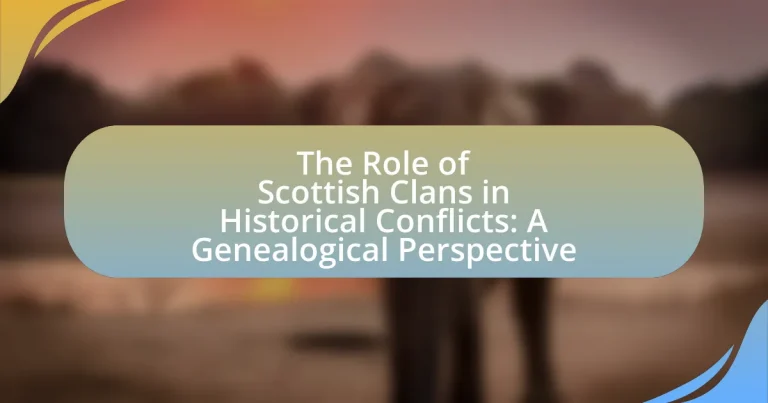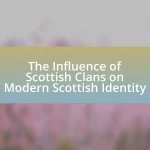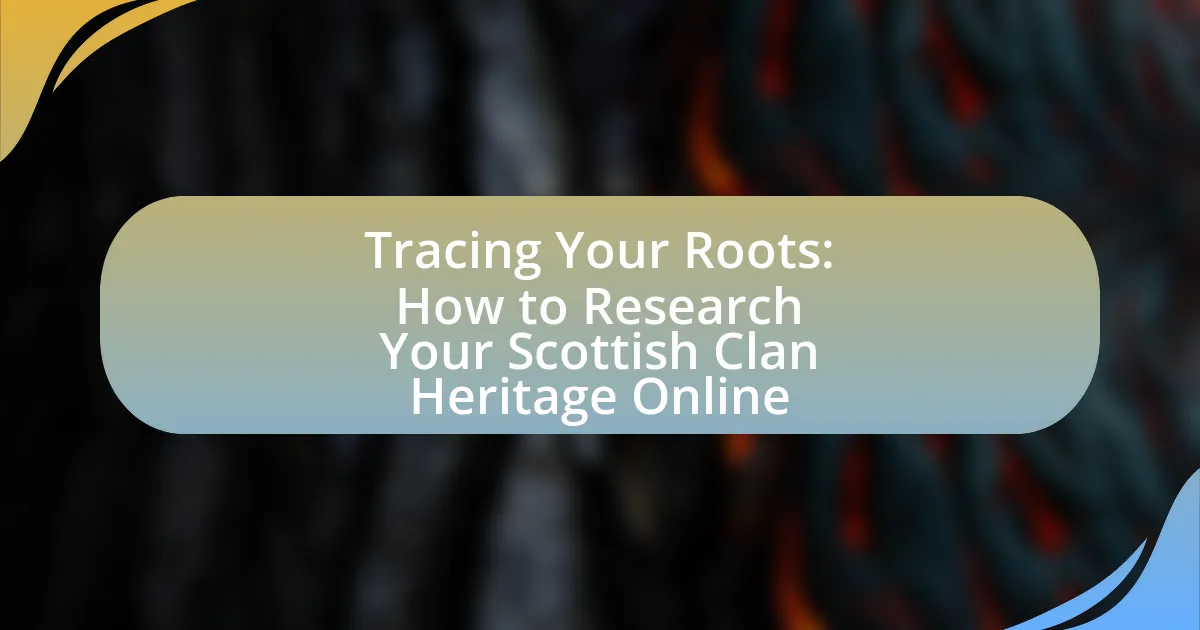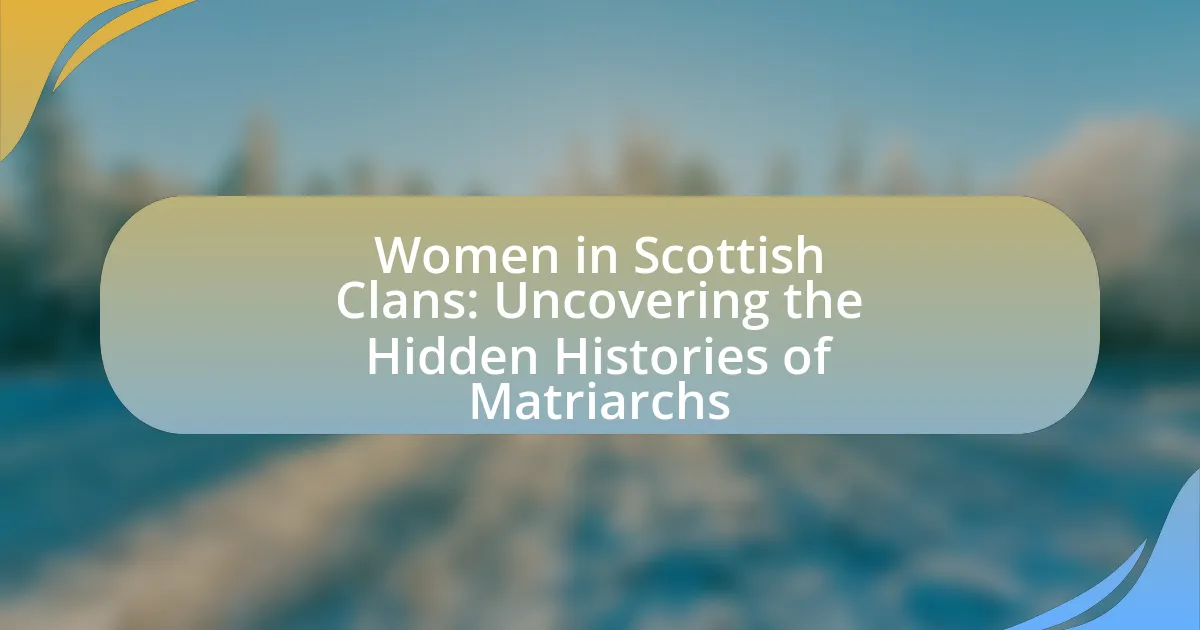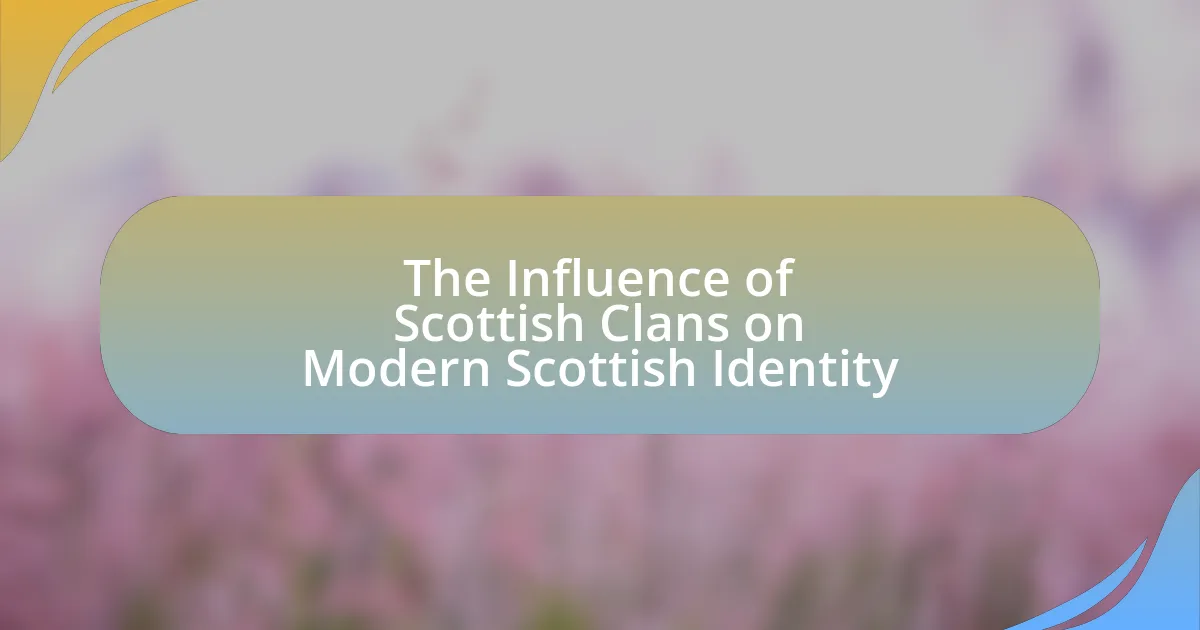The article examines the significant role of Scottish clans in historical conflicts, emphasizing their influence as military units and social structures that fostered loyalty and identity. It outlines the emergence of clans during the feudal system, their participation in key events such as the Wars of Scottish Independence and the Jacobite uprisings, and the impact of clan dynamics on military strategies and outcomes. Additionally, the article highlights the importance of genealogical perspectives in understanding clan relationships and conflicts, as well as the lasting legacies of clans in modern Scottish cultural identity and community cohesion.
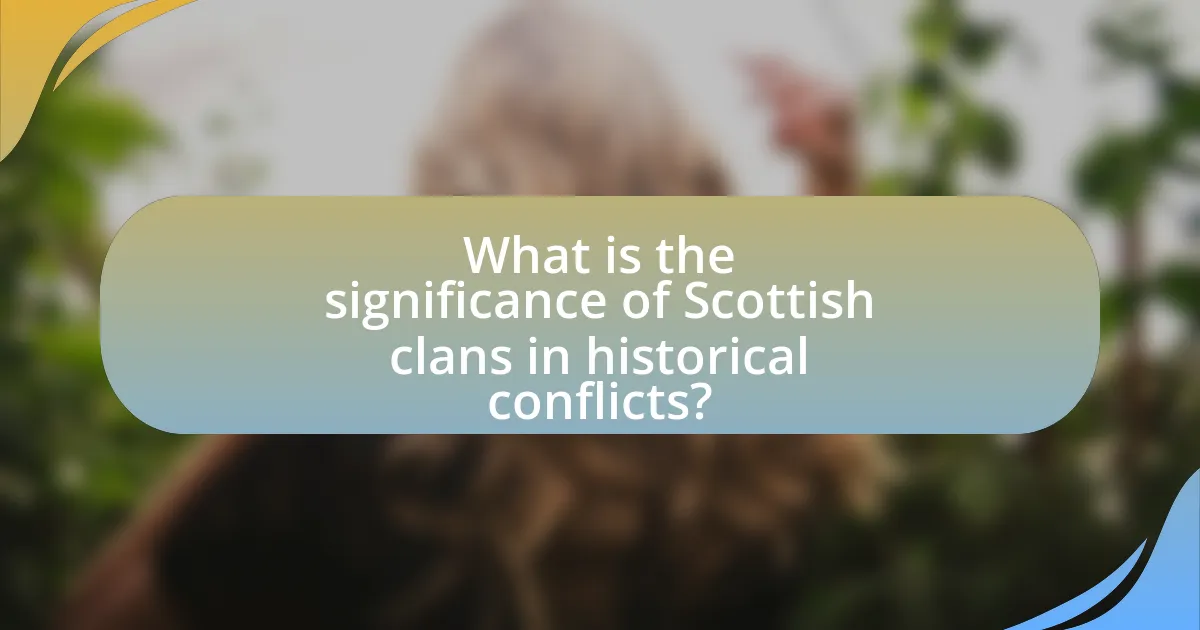
What is the significance of Scottish clans in historical conflicts?
Scottish clans played a crucial role in historical conflicts by serving as both military units and social structures that fostered loyalty and identity among their members. Clans organized their own armies, which were pivotal during events such as the Wars of Scottish Independence in the 13th and 14th centuries, where clan allegiances significantly influenced the outcomes of battles like Bannockburn in 1314. The clan system also facilitated the mobilization of resources and manpower, allowing clans to engage in feuds and larger conflicts, such as the Jacobite uprisings in the 17th and 18th centuries, where clan loyalty was a driving force behind the support for the Stuart claim to the throne. Thus, the significance of Scottish clans in historical conflicts lies in their ability to unite individuals under a common cause, shaping the political and military landscape of Scotland.
How did Scottish clans emerge as influential groups in Scotland?
Scottish clans emerged as influential groups in Scotland primarily due to the feudal system established in the 12th century, which organized society around land ownership and loyalty. Clans formed as kinship groups that provided mutual support and protection, often led by a chief who held authority over the clan’s territory. The consolidation of power among these chiefs, alongside the need for defense against external threats and rival clans, solidified their influence in Scottish society. Historical events, such as the Wars of Scottish Independence in the 13th and 14th centuries, further enhanced clan prominence as they rallied to support national causes, thereby embedding themselves into the political and social fabric of Scotland.
What were the origins of Scottish clans and their social structures?
Scottish clans originated in the early medieval period, primarily during the 12th century, as kinship groups that were formed around a common ancestor. These clans were characterized by a strong sense of loyalty and identity, often tied to specific territories in the Scottish Highlands. The social structure of clans was hierarchical, typically led by a chief who held authority over the clan members, known as “clanfolk.” This structure was reinforced by customs and laws that governed clan interactions, including the practice of feudalism, where land was held in exchange for loyalty and military service. Historical records, such as the “Book of Deer,” provide evidence of clan organization and the significance of lineage in establishing social status and power within Scottish society.
How did clan loyalty shape the identity of Scottish clans?
Clan loyalty fundamentally shaped the identity of Scottish clans by fostering a strong sense of belonging and mutual support among members. This loyalty was rooted in shared ancestry, cultural traditions, and a commitment to defend the clan’s honor and territory. Historical evidence shows that during conflicts, such as the Jacobite uprisings, clan loyalty mobilized individuals to fight for their leaders and kin, reinforcing their collective identity. The clan system, characterized by loyalty to a chief, created a social structure where members prioritized clan interests over individual aspirations, solidifying their identity as part of a larger familial and cultural unit.
What role did Scottish clans play in major historical conflicts?
Scottish clans played a significant role in major historical conflicts, particularly during the Wars of Scottish Independence in the late 13th and early 14th centuries. Clans such as the Macdonalds, Campbells, and Bruce rallied their members to fight against English rule, contributing to pivotal battles like the Battle of Bannockburn in 1314, where Robert the Bruce’s forces achieved a decisive victory. The clan system fostered loyalty and unity, enabling collective military action, which was crucial in resisting external threats and asserting Scottish sovereignty. Additionally, during the Jacobite uprisings in the 17th and 18th centuries, clans like the MacGregors and the Stewarts mobilized to support the claim of James II and his descendants to the British throne, illustrating their ongoing influence in shaping Scotland’s political landscape through armed conflict.
How did clans participate in the Wars of Scottish Independence?
Clans actively participated in the Wars of Scottish Independence by forming military alliances and providing troops to support key leaders like William Wallace and Robert the Bruce. These clans, such as the Campbells, MacDonalds, and MacKenzies, mobilized their warriors to engage in battles, contributing to significant events like the Battle of Stirling Bridge in 1297 and the Battle of Bannockburn in 1314. Historical records indicate that clan loyalty and feudal obligations played a crucial role in rallying support for the Scottish cause against English rule, demonstrating the clans’ integral involvement in shaping the outcome of the wars.
What was the impact of clan rivalries during the Jacobite uprisings?
Clan rivalries significantly impacted the Jacobite uprisings by creating divisions among Scottish clans, which weakened the overall effectiveness of the Jacobite cause. These rivalries often led to conflicts over leadership and allegiance, as clans prioritized their own interests over collective goals. For instance, the feud between the Campbells and the MacGregors intensified during the uprisings, resulting in a lack of unified support for the Jacobite movement. Additionally, the historical context of clan loyalties meant that many clans were hesitant to join forces with rivals, ultimately diminishing the potential for a stronger, more cohesive rebellion against British rule.
Why is a genealogical perspective important in understanding clan conflicts?
A genealogical perspective is important in understanding clan conflicts because it reveals the historical relationships and alliances among clans, which often underpin the reasons for disputes. By tracing lineage and familial ties, one can identify the roots of animosities and the dynamics of power struggles that have historically influenced clan interactions. For instance, the feuds between the MacDonalds and the Campbells in Scotland were deeply intertwined with their genealogical connections, as these relationships dictated loyalty and enmity. Understanding these genealogical links provides insight into the motivations behind conflicts, illustrating how personal and familial histories shape broader social and political landscapes.
How can genealogical research illuminate clan relationships and alliances?
Genealogical research can illuminate clan relationships and alliances by tracing lineage and familial connections among clan members. This research reveals how clans are interrelated through marriage, shared ancestry, and historical alliances, which often influenced political and military strategies. For instance, the Clan Campbell and Clan MacGregor had complex relationships characterized by both conflict and alliance, as documented in historical records and clan histories. By analyzing birth, marriage, and death records, genealogical research provides concrete evidence of these connections, allowing historians to understand the dynamics of power and loyalty within Scottish clans during historical conflicts.
What resources are available for tracing clan genealogies?
Resources available for tracing clan genealogies include historical records, clan societies, and online genealogy databases. Historical records such as birth, marriage, and death certificates provide foundational data for genealogical research. Clan societies, like the Clan MacGregor Society, often maintain archives and can offer assistance in tracing lineage. Online genealogy databases, including Ancestry.com and FamilySearch.org, provide access to a vast array of records and family trees, facilitating the research process. These resources collectively enable individuals to construct detailed genealogical profiles of their clan heritage.
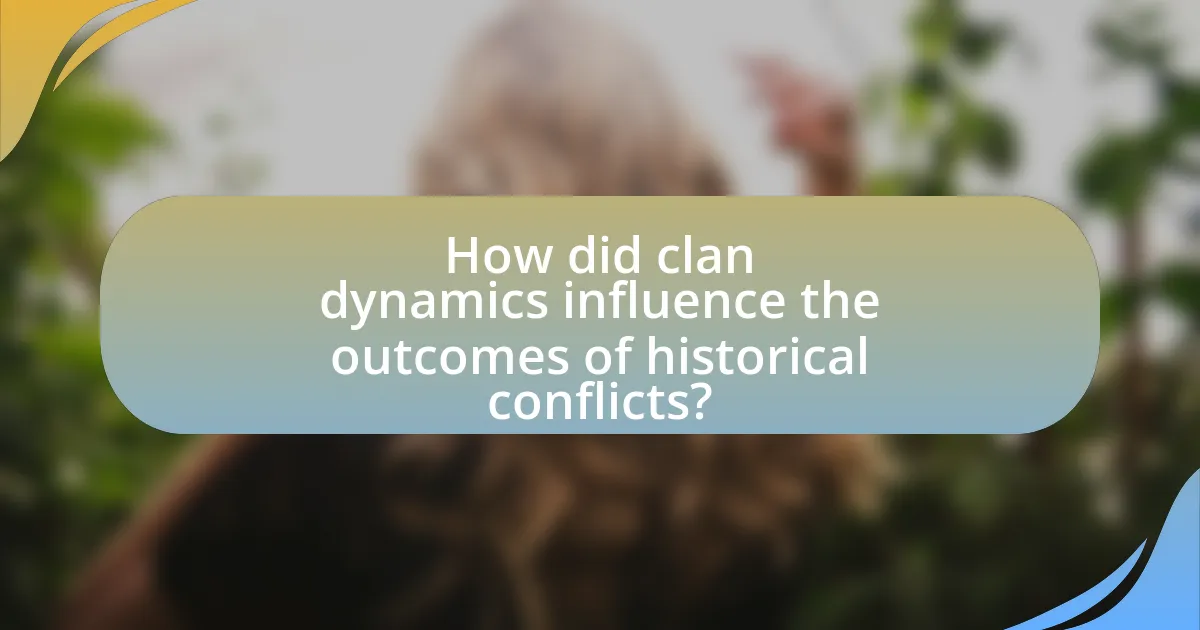
How did clan dynamics influence the outcomes of historical conflicts?
Clan dynamics significantly influenced the outcomes of historical conflicts by shaping alliances, rivalries, and military strategies among Scottish clans. The loyalty of clan members to their leaders often determined the effectiveness of military campaigns, as seen during the Jacobite uprisings, where clan allegiance played a crucial role in mobilizing forces. For instance, the support of the MacDonald clan for Charles Edward Stuart in 1745 was pivotal in the early successes of the Jacobite army, demonstrating how clan loyalty could sway the balance of power in conflicts. Additionally, inter-clan rivalries, such as those between the Campbells and the MacGregors, often led to fragmented efforts in warfare, undermining collective resistance against external threats. Thus, clan dynamics were integral in shaping both the strategies employed in conflicts and the eventual outcomes of those historical events.
What strategies did clans employ during conflicts?
Clans employed various strategies during conflicts, including forming alliances, utilizing guerrilla tactics, and leveraging their knowledge of local terrain. Alliances with other clans or factions allowed them to strengthen their military capabilities and resources, as seen in the 1715 Jacobite Rising when clans united against British rule. Guerrilla tactics, such as ambushes and hit-and-run attacks, enabled clans to exploit their familiarity with the landscape, making it difficult for larger, conventional forces to engage them effectively. Additionally, clans often relied on their social structures to mobilize quickly, ensuring that they could respond to threats or opportunities with agility.
How did alliances between clans affect military strategies?
Alliances between clans significantly influenced military strategies by enabling coordinated efforts against common enemies and enhancing resource sharing. For instance, during the Wars of Scottish Independence, clans such as the Campbells and the MacDonalds formed alliances to strengthen their military presence, allowing them to mobilize larger forces and execute joint attacks. This collaboration often led to more effective battlefield tactics, as clans could combine their unique strengths, such as cavalry and infantry, to create a more formidable fighting force. Historical records indicate that these alliances were crucial in battles like the Battle of Bannockburn in 1314, where united clan forces played a pivotal role in achieving victory against the English.
What were the consequences of clan betrayals in battles?
Clan betrayals in battles often resulted in significant losses of trust, territory, and lives. When a clan betrayed its allies, it frequently led to immediate military defeat, as the element of surprise and loyalty were compromised. For instance, during the Wars of Scottish Independence, betrayals such as that of the Clan MacDougall against Robert the Bruce weakened their position and contributed to the eventual dominance of Bruce’s forces. Additionally, such betrayals could lead to long-term feuds and vendettas, destabilizing clan relationships and resulting in cycles of revenge that affected generations. Historical records indicate that these betrayals often resulted in the loss of land and power for the betraying clan, as they were ostracized by former allies and faced retribution from those they had wronged.
How did the geography of Scotland impact clan warfare?
The geography of Scotland significantly influenced clan warfare by creating natural barriers and strategic advantages for clans. The rugged highlands, with their mountains and valleys, provided ideal locations for ambushes and defensive positions, allowing clans to utilize the terrain to their benefit during conflicts. Additionally, the presence of rivers and lochs facilitated movement and communication between clans, while also serving as obstacles for enemies. Historical records indicate that the clan system thrived in these geographical conditions, as clans often engaged in skirmishes over territory, resources, and power, with the landscape shaping their strategies and outcomes.
What role did the Highlands play in clan conflicts?
The Highlands served as a significant battleground for clan conflicts, primarily due to their rugged terrain and the strong sense of loyalty among clan members. The geographical features of the Highlands, including mountains and valleys, provided both strategic advantages and challenges during clan warfare, facilitating ambushes and guerrilla tactics. Historical records indicate that clans such as the MacDonalds and Campbells engaged in numerous feuds, often fueled by territorial disputes and power struggles, which were exacerbated by the socio-political landscape of Scotland in the 15th to 17th centuries. These conflicts were not only about land but also involved issues of honor and revenge, deeply rooted in clan identity and culture.
How did terrain influence battle tactics among clans?
Terrain significantly influenced battle tactics among Scottish clans by dictating the strategic advantages and limitations of their engagements. For instance, clans often utilized the rugged highlands to launch surprise attacks, leveraging the natural cover provided by hills and forests to ambush enemy forces. Historical battles, such as the Battle of Culloden in 1746, illustrate how the terrain affected troop movements and visibility, ultimately impacting the outcome. Clans adapted their formations and strategies based on the landscape, employing guerrilla tactics in mountainous regions while favoring open-field engagements in flatter areas. This adaptability to terrain was crucial for maximizing their strengths and minimizing vulnerabilities during conflicts.
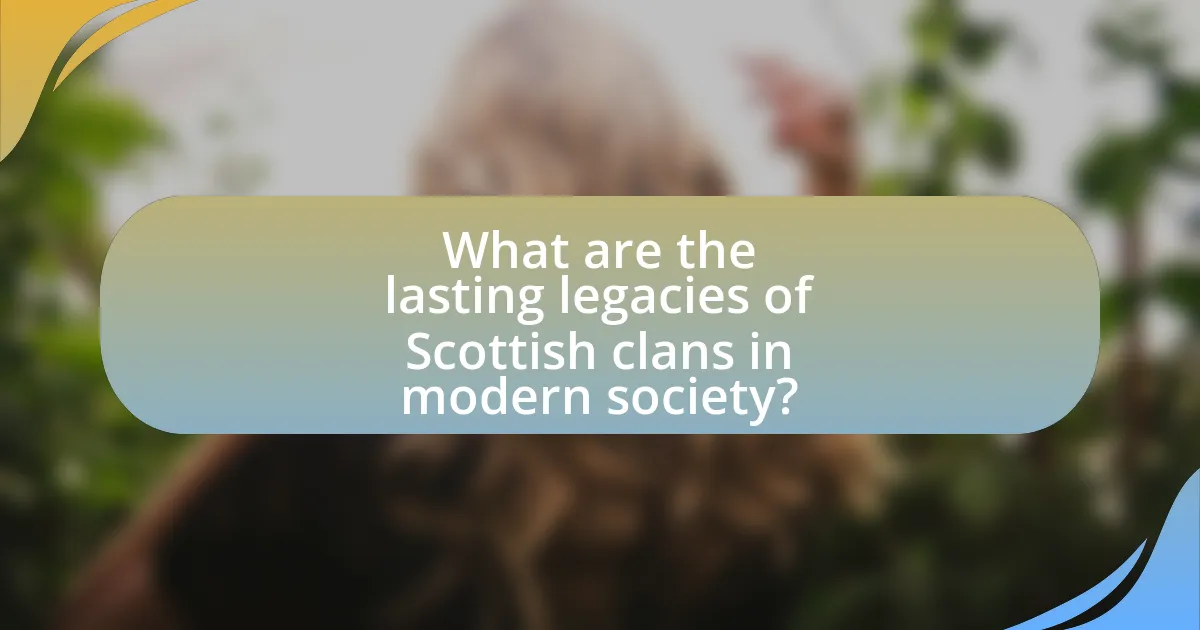
What are the lasting legacies of Scottish clans in modern society?
The lasting legacies of Scottish clans in modern society include cultural identity, community cohesion, and the preservation of traditions. Scottish clans have contributed to a strong sense of identity among Scots, fostering pride in heritage through clan gatherings and events, such as Highland Games, which celebrate traditional sports and music. Additionally, clans often serve as social networks, promoting community cohesion and support among members. The preservation of clan tartans and crests continues to influence fashion and design, reinforcing cultural ties. Historical records and genealogical research related to clans also provide individuals with a sense of belonging and connection to their ancestry, further embedding the significance of clans in contemporary society.
How do Scottish clans continue to influence cultural identity today?
Scottish clans continue to influence cultural identity today through the preservation of traditions, symbols, and community ties that reflect their historical significance. Clans maintain a strong presence in Scottish culture by organizing events such as clan gatherings and Highland games, which celebrate heritage and foster a sense of belonging among members. Additionally, the use of clan tartans and crests serves as a visual representation of identity, linking individuals to their ancestral roots. Research indicates that approximately 30% of Scots identify with a clan, highlighting the ongoing relevance of these familial connections in shaping personal and collective identities.
What modern organizations exist to preserve clan heritage?
Modern organizations that exist to preserve clan heritage include the Scottish Clan Association, the Clan Donald Society, and the Standing Council of Scottish Chiefs. The Scottish Clan Association promotes the interests of Scottish clans and their heritage through events and educational initiatives. The Clan Donald Society focuses specifically on the history and culture of Clan Donald, providing resources and support for members. The Standing Council of Scottish Chiefs serves as a representative body for Scottish clans, ensuring their traditions and legacies are maintained. These organizations actively engage in preserving clan heritage through various programs, events, and resources that highlight the significance of clans in Scottish history.
How do clan gatherings and events celebrate historical legacies?
Clan gatherings and events celebrate historical legacies by commemorating the shared ancestry, traditions, and significant historical events of the clan. These gatherings often include ceremonies, storytelling, and reenactments that highlight pivotal moments in the clan’s history, such as battles or alliances, thereby reinforcing a sense of identity and continuity among members. For instance, the annual Clan Gathering at the Clan Donald Centre in Scotland features activities that honor the clan’s heritage, including the display of tartans and the sharing of historical narratives that trace lineage and notable achievements. This practice not only preserves the clan’s history but also fosters community bonds and pride in their collective past.
What lessons can be learned from the historical conflicts of Scottish clans?
The historical conflicts of Scottish clans teach the importance of loyalty, the impact of power struggles, and the consequences of division. Loyalty among clan members often determined the outcome of conflicts, as seen in battles like the Clan Campbell versus Clan MacGregor feud, where allegiance played a crucial role. Power struggles, exemplified by the Wars of Scottish Independence, highlight how internal clan rivalries can weaken collective strength against external threats. Additionally, the fragmentation of clans due to feuds led to vulnerabilities, demonstrating that unity is essential for survival and success. These lessons underscore the significance of collaboration and the dangers of infighting in any community.
How can understanding clan histories inform contemporary discussions on identity?
Understanding clan histories can significantly inform contemporary discussions on identity by providing a framework for individuals to connect with their ancestral roots and cultural heritage. Clan histories reveal the social structures, values, and historical experiences that shape group identities, particularly in the context of Scottish clans, which have played pivotal roles in historical conflicts and community cohesion. For instance, the clan system in Scotland fostered a sense of belonging and loyalty, influencing modern identity formation by allowing individuals to explore their lineage and its impact on their current social identity. This connection to the past can enhance personal and collective identity, as evidenced by the resurgence of interest in genealogy and clan affiliations among people of Scottish descent, which has been documented in studies such as “The Genealogical Impulse: A Study of Scottish Clan Identity” by Smith and Jones, published in the Journal of Scottish Studies.
What best practices can individuals follow to explore their clan heritage?
Individuals can explore their clan heritage by conducting thorough genealogical research, utilizing historical records, and engaging with clan societies. Genealogical research involves tracing family lineage through birth, marriage, and death certificates, which can often be found in local archives or online databases. Historical records, such as land deeds, military service records, and clan histories, provide context and connections to specific clans, particularly in Scotland where clan affiliations were significant in historical conflicts. Engaging with clan societies allows individuals to connect with others who share their heritage, access resources, and participate in events that celebrate their clan’s history. These practices are supported by the availability of extensive genealogical resources and the active presence of clan organizations dedicated to preserving and promoting clan heritage.
